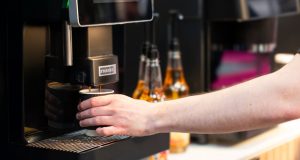Mitie Group’s new office at the Shard is not just a cool workplace, it’s a showcase for the company’s connected workspace strategy. Sara Bean went to take a look
In February 2018, Mitie Group plc moved into the iconic Shard building in London, where it took on the entire 12th floor, covering 2,784 sq m, under a 15-year lease. Around 250 employees moved in from three locations – Counting House, Cottons and Lime Harbour – to one shared space, which now includes the professional services and connected workspaces team, engineering and cleaning teams and group functions such as HR, finance, comms, legal and IT.
 The reasons behind the move were intriguing. Aside from bringing together a disparate group of teams to operate as ‘one Mitie’, the Shard HQ is also intended to showcase what Mitie can offer clients, whether facilities management – such as front of house, cleaning or catering – or its occupation design function. But it also serves as a practical demonstration of Mitie’s new strategy, the connected workspace, which utilises data analytics to help improve operational efficiency.
The reasons behind the move were intriguing. Aside from bringing together a disparate group of teams to operate as ‘one Mitie’, the Shard HQ is also intended to showcase what Mitie can offer clients, whether facilities management – such as front of house, cleaning or catering – or its occupation design function. But it also serves as a practical demonstration of Mitie’s new strategy, the connected workspace, which utilises data analytics to help improve operational efficiency.
Another interesting point is that all aspects of the move, from identifying the new location to moving in the staff, was carried out by Mitie’s own people.
Explains Andrew Smart, Head of Occupier Services: “When we decided to take on new space and move in here, we went through quite a lengthy process that started with the selection of the building. We carried out a location analysis, looked at travel distances, all the things you’d expect us to do if we were carrying out the process for a client. We made a shortlist of locations, and from that the Shard was our preferred destination.”
The main factors behind that decision were to have a single footplate with everybody on one floor, a good location in terms of travel connections, and control over the design, with the freedom to deliver the space the way Mitie wanted it to be.
According to Chris Rowley, MD of Professional Services, there was a broader context to the decision. He says: “It all started in relation to our consolidation programme across Mitie’s property estate. Partly due to how the organisation had grown up over time, we had three buildings in London, which meant the teams found it more difficult to get together. We wanted people to have the opportunity to collaborate.”
Given that the leasing agreement was only finalised last September, there was limited time to get everything ready before staff moved in on 12 February. For once, Mitie’s professional services team were managing a project for their own organisation rather than a client. Move champions were identified to help  input into the new design, WebEX sessions were organised to share information, and staff were given the opportunity to suggest designs, furniture and fittings.
input into the new design, WebEX sessions were organised to share information, and staff were given the opportunity to suggest designs, furniture and fittings.
Says Rowley: “Collaboration is one of those things that people sometimes don’t think about enough, but for us, it was a key part of the process and the team put a lot of effort into it. It’s not quite over yet – we’re still re-emphasising messages to help drive changes in behaviour, for example ensuring people observe the clear desk policy and use their locker spaces properly.”
While the HR department was a key stakeholder, as a key part of the change management process, the project was FM led. Comments Smart: “The important thing for me was you’ve got to keep it practical and real and be able to take the concept and relate it to how you work, so you’ve got to be from our world. Because we did this ourselves, there’s a huge amount of pride in what’s been done as it’s our own team. We came up with the concept, we carried out the location analysis, the design concept, the move programme, we project managed it and moved everybody in, and are continuing to do the adaptation now.
“It’s a home-grown product, which is not only a great result for Mitie as our own space, it’s also a bit of a shop window for us because it demonstrates what we’re capable of doing. Which is quite different to what Mitie is traditionally known for.”
Rowley adds: “It also reflects our vision of FM, to create exceptional places to work that ultimately help our clients and employees perform to the highest standard in a high-performance workplace. It’s about bringing some of those techniques and design capabilities together.”




